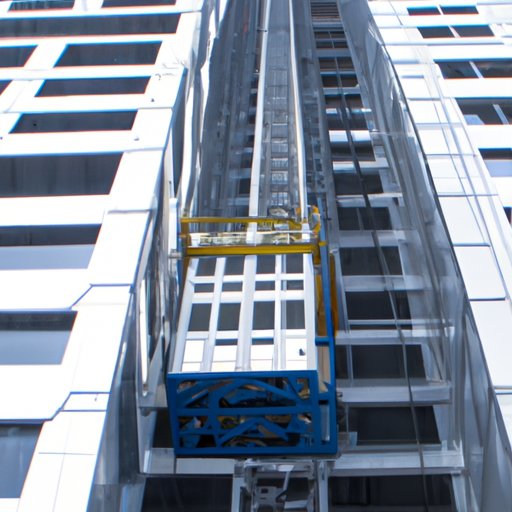Introduction
Skyscrapers are tall, multi-story buildings that have become a defining feature of urban landscapes around the world. The first skyscrapers were built in the late 19th century in Chicago, and since then they have been constructed in cities across the globe. But what technological advances made it possible to build these towering structures? In this article we explore the key technologies that enabled the development of skyscrapers.
A History of Skyscraper Building
Prior to the 19th century, most buildings were limited to two or three stories due to the limitations of the materials and construction techniques available at the time. However, technological advancements in the 19th century allowed for taller structures to be built. These included the development of cast iron and steel framed structures, which were much stronger than the timber and masonry buildings used previously. This enabled architects to design taller and more ambitious structures.
The introduction of reinforced concrete in the early 20th century was another major breakthrough for skyscraper construction. This new material was stronger and more flexible than traditional masonry, allowing for the construction of larger and higher buildings. The invention of the elevator also played an important role in making skyscraper construction possible. Elevators allowed people to move between floors quickly and safely, enabling them to access the upper levels of tall buildings.
“It was the combination of steel and reinforced concrete that really enabled the construction of tall buildings,” explains structural engineer Richard S. Hartman. “These materials allowed for greater flexibility in design and enabled architects to create taller and more ambitious structures.”

Exploring the Technologies That Make Skyscrapers Possible
In order to understand how skyscrapers are built today, it is important to examine the key technologies that make them possible. These include steel framed structures, reinforced concrete, elevators and high-speed lifts, fire protection systems, and automated building designs.
Steel framed structures are the most common type of construction used in skyscrapers. Steel is strong, lightweight, and easy to work with, making it ideal for building tall structures. Steel frames can be designed to be as strong or as flexible as needed, allowing for the creation of complex and intricate designs. Reinforced concrete is also widely used in the construction of skyscrapers. This material is strong and durable, and it can be formed into any shape desired. It is also relatively inexpensive, making it a popular choice for many skyscrapers.
Elevators and high-speed lifts are essential for the construction of skyscrapers. Without them, it would be difficult to access the upper levels of the building. Elevators are also important for ensuring the safety of occupants in case of fire or other emergency. Fire protection systems are also essential for skyscrapers. These systems help to contain fires and minimize damage, allowing occupants to safely evacuate the building if necessary.
Finally, automated building designs are becoming increasingly popular in modern skyscrapers. Automated systems can be used to control various aspects of the building, including lighting, air conditioning, security, and more. This allows for greater efficiency and safety, as well as reducing maintenance costs.

The Evolution of Skyscrapers: A Review of Key Technologies
Let’s take a closer look at the technologies that make skyscrapers possible:
1. Steel Framed Structures
Steel is one of the strongest and most versatile materials available for construction. Steel frames can be designed to be as strong or as flexible as needed, allowing for the creation of complex and intricate designs. Steel frames are also lightweight and easy to work with, making them ideal for constructing tall buildings.
2. Reinforced Concrete
Reinforced concrete is a strong and durable material that can be formed into any shape desired. It is also relatively inexpensive, making it a popular choice for many skyscrapers. This material is used in the construction of the building’s core, as well as its walls and floors.
3. Elevators and High-Speed Lifts
Elevators and high-speed lifts are essential for accessing the upper levels of tall buildings. They also provide an additional layer of safety in case of fire or other emergency. Modern elevators are designed to be energy efficient and can travel at speeds of up to 18 mph.
4. Fire Protection Systems
Fire protection systems are essential for skyscrapers. These systems help to contain fires and minimize damage, allowing occupants to safely evacuate the building if necessary. Fire protection systems typically include sprinklers, smoke detectors, and fire alarms.
5. Automated Building Designs
Automated building designs are becoming increasingly popular in modern skyscrapers. Automated systems can be used to control various aspects of the building, including lighting, air conditioning, security, and more. This allows for greater efficiency and safety, as well as reducing maintenance costs.
Conclusion
Skyscrapers are an impressive feat of engineering and design. They are made possible by a variety of technological advancements, including steel framed structures, reinforced concrete, elevators and high-speed lifts, fire protection systems, and automated building designs. These technologies have enabled architects to create taller and more ambitious structures, transforming the skylines of cities around the world.
(Note: Is this article not meeting your expectations? Do you have knowledge or insights to share? Unlock new opportunities and expand your reach by joining our authors team. Click Registration to join us and share your expertise with our readers.)
